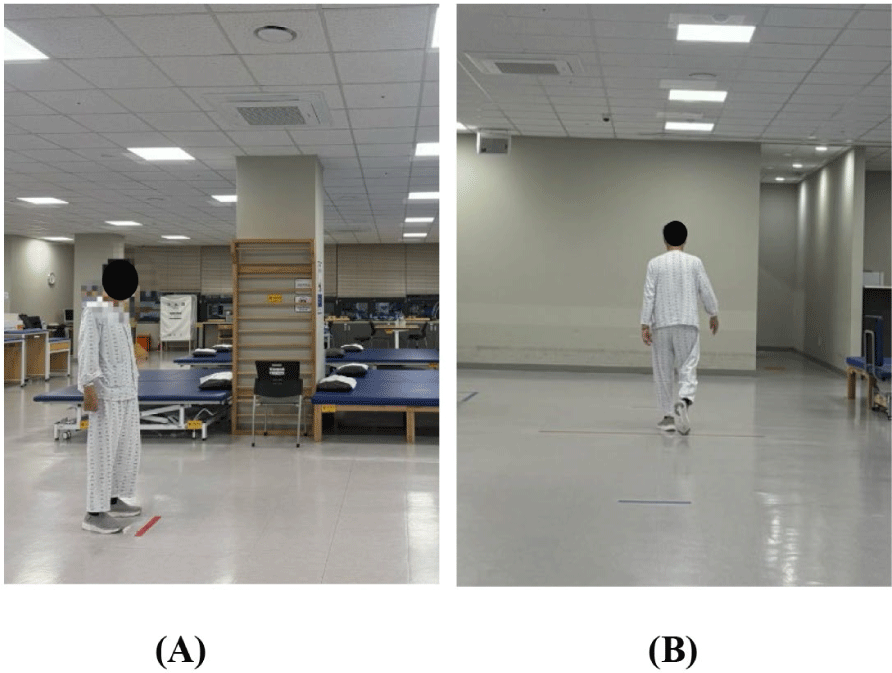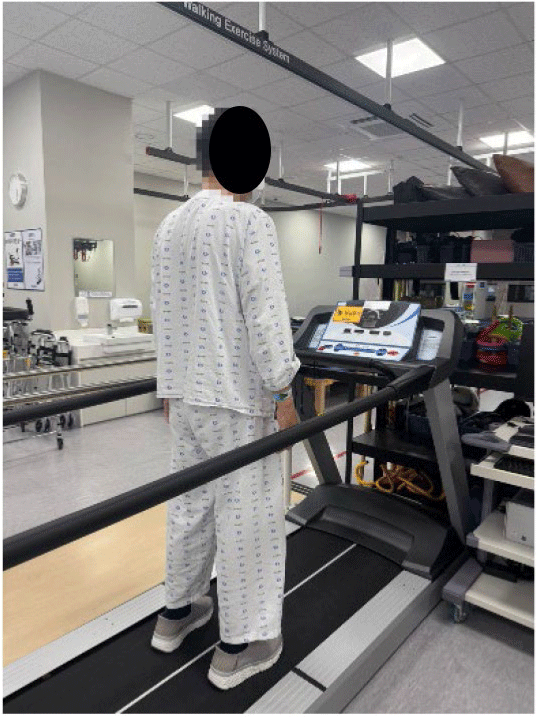INTRODUCTION
Stroke is a central nervous system disease with a high incidence and mortality rate worldwide, and is caused by a disruption of blood supply to brain neurons due to cerebral hemorrhage or cerebral infarction.1 Stroke causes complex motor, sensory, cognitive, and emotional impairment,2 which leads to asymmetrical postural alignment and a decreased ability to maintain symmetrical weight bearing.3 Fear of falling reduces the confidence of stroke patients, interferes with their daily lives, and lowers their quality of life.4 Therefore, the process of restoring balance is essential for returning to daily life, and this can contribute to preventing falls and improving function.5
One of the most significant losses after stroke is the loss of walking ability, which is a major goal of rehabilitation treatment.6 Walking is a basic method of locomotion that is achieved through the coordination of multiple joints and muscles, and the feet play an important role in bearing weight as the only support surface of the body.7,8 However, the upright posture is inherently unstable because it requires maintaining a high center of pressure on a relatively small base of support.9 To compensate for this instability, the muscles of the waist and legs are activated to provide stability.10 Some studies have reported that walking problems in stroke patients further deteriorate physical function, disrupting independent and functional movements and ultimately limiting social participation.11 Strengthening exercises for the lower extremities are necessary to improve the walking function of stroke patients.12 A study that performed strength-enhancing exercises showed that the strength of the paralyzed leg significantly improved in chronic stroke pa-tients, and functional performance, walking speed, and stair climbing ability were improved.13
The squat, a representative closed-chain exercise,14 contributes to the development of thigh muscle groups and strengthens the quadriceps muscle by activating multiple joints through weight support.15 It has been reported that squat exercise is effective in improving muscle activity and central pressure movement in stroke patients, which can be linked to balance training to prevent the use of affected sides.16 However, squat exercise is difficult to maintain posture and center of gravity, so the weight load is transferred to the lower back and knee joints, which can cause injury.17 To compensate for this, the wall squat exercise was proposed. The wall squat exercise can be performed safely without the risk of back or knee injuries because it transfers body weight to the wall, and is a suitable exercise for beginners.
In addition, elastic bands are inexpensive, easy to carry, have a low risk of injury, and can provide resistance at various angles, making them suitable for improving muscle strength and body balance.18,19 One study reported that bridge exercise using an elastic band promoted muscle activity in the middle gluteus medius muscle compared to bridge exercise without an elastic band.20 In addition, elastic band exercise helps prevent muscle strength decline and improve balance and walking ability.21 Another study reported that the results of applying elastic band exercise for 12 weeks to patients with hemiplegia due to stroke showed a positive effect in preventing decline in physical strength in daily life and balance ability due to decline in leg muscle strength and in preventing falls.19
Neurological and functional impairments are closely related to stable walking speed, and it has been reported that hip strength plays an important role.22 The hip abductor muscles stabilize the hip joint posture during walking and are essential for independent walking and balance recovery.23,24 It was reported that balance and walking were improved as a result of performing hip-joint abductor strengthening exercises in stroke patients.25 Plantar pressure is an important indicator of the qualitative status of balance and gait, and measures the pressure applied to the entire foot during daily life.26 Plantar pressure outside the normal range can cause physiological disorders and musculoskeletal damage, and that repeated imbalanced weight bearing causes postural misalignment.27 Most stroke patients have a higher level of pressure on the paralyzed side than on the paralyzed side. More weight is supported on the non-paretic side,28 which increases the instability of body balance and postural control, causing various problems.29 Therefore, biofeedback using a plantar pressure sensor has the potential to contribute to improving gait in stroke patients.30
For stroke patients, squat exercise is an effective exercise to strengthen leg muscles, but it can be a burdensome exercise due to the difficulty in maintaining balance and the risk of falling. As an alternative, applying wall squat exercise can increase stability by using the wall, thereby reducing the risk of falling, and can expect muscle strengthening effects similar to those of regular squats. In particular, applying elastic bands to the knees can more effectively activate the gluteus medius muscle, which plays an important role in walking, and is expected to have a positive effect on improving walking ability. Therefore, in this study, we analyzed the effects of wall squat exercise using elastic bands on leg muscle strength, walking, and plantar pressure in chronic stroke patients and aimed to suggest a safer and more effective intervention method.
METHODS
The subjects of this study were 30 chronic stroke patients admitted to Daegu Hospital. The 30 subjects were randomly divided into an experimental group (n=15) and a control group (n=15), but some dropped out due to discharge during the intervention process, resulting in 11 subjects in the experimental group and 12 subjects in the control group. Before participating in this study, all subjects received a sufficient explanation of the purpose of the study and gave written consent. The study was conducted after obtaining approval from the Daegu University Institutional Review Board (Approval Number: 1040621-202407-HR-058). The general characteristics of the subjects are as follows (Table 1).
Both the experimental and control groups used the wall squat exercise method.31 The experimental group performed wall squats with an elastic band 5 cm above their knees (Figure 1), while the control group performed wall squats in the same way as the experimental group without using an elastic band (Figure 2). One set consisted of 10 repetitions of sitting and standing up against the wall, and a total of 10 sets were performed. The exercise was performed 3 times a week for a total of 6 weeks with a 15-second rest period between sets.
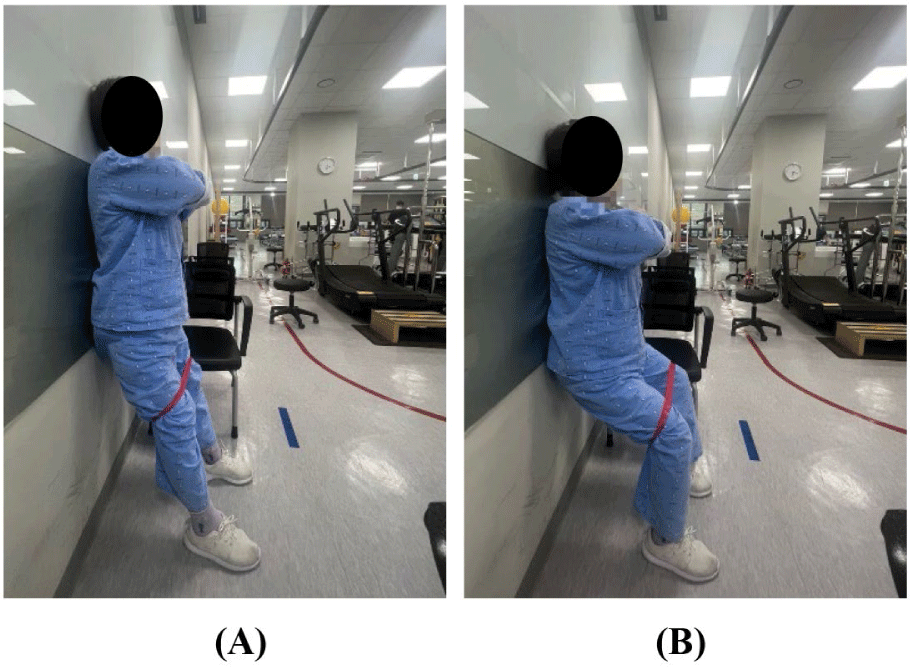
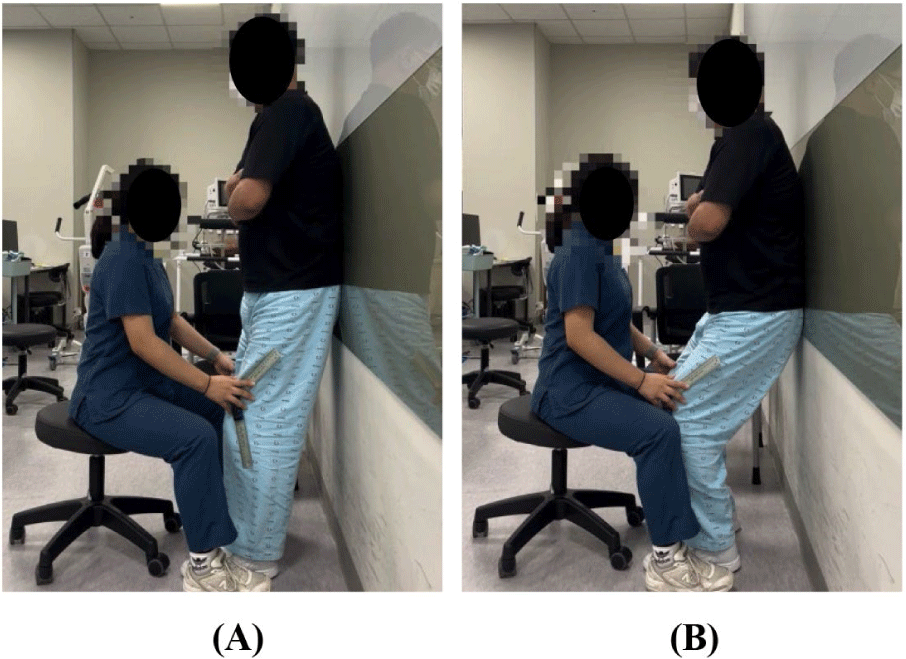
In this study, the leg muscle strength was evaluated using a manual muscle tester (Model 01165, Lafayette, USA) on the knee extensors, knee flexors, and hip abductors of the non-paretic and paretic sides. The muscle strength measurement positions were selected from the positions listed in the muscle strength examination textbook.32 The pressure that appears during the maximum isometric contraction of each muscle was measured, and the average of three measurements was recorded. A 15-second rest was taken between each measurement to exclude muscle fatigue. The maximum force value was used to evaluate muscle strength in this study.
The 10m Walking Test (10MWT) was used to evaluate walking performance. The time taken by the subject to walk 10 m, excluding the 2 m acceleration section at the starting point and the 2 m deceleration section at the final destination, while the subject walked a total distance of 14 m was measured. The subjects repeated the measurement three times in total at a safe but fast speed, and the average value was calculated. In order to minimize the subject's fatigue, the time interval between each measurement was measured again after a 30-second rest using a stopwatch (Figure 3).
In this study, the Zebris FDM-T Treadmill (Zebris, Germany) was used as an evaluation tool to measure the plantar pressure of the subjects in a standing position before and after exercise. In this study, for measurement, the subjects were instructed to stand upright on the treadmill, look straight ahead, and maintain a standing posture for 30 seconds (Figure 4). In this study, the average pressure ratio values of the forefoot, hindfoot, and entire foot were used to evaluate the plantar pressure of the paretic and non-paretic sides.
All statistical analyses of the data collected in this study were performed using the SPSS (statistical package for the social sciences) version 23.0 for window software (SPSS Inc., Chicago). Data processing on the general characteris-tics of the research subjects was described using descriptive statistics. In order to compare the differences between groups over time, two-way repeated measures ANOVA was used, and the significance level was set at α =.05. In order to check for interaction, the Bonferroni test was performed, and the significance level was set at α =.017.
RESULTS
As a result of the manual muscle strength test of the control group and the experimental group, the muscle strength level increased in both groups, and in particular, the results of the experimental group were better, but no statistically significant results were found (Table 2).
There was a difference in the strength of the hip joint abductor muscles on the paretic side between the two groups at each time point (p<.05), and there was no statistically significant difference in the change in each group at each time point (p>.05). There was a significant difference in the interaction between the time point and the group (p<.05). (Table 3 and Figure 5)
| Pre | Post | Difference value | T | Change rate (%) | P | |
|---|---|---|---|---|---|---|
| EG | 14.66±6.21 | 20.92±4.98 | 6.26±1.23 | -4.01 | 42.70% | 0.002* |
| CG | 15.04±4.48 | 17.43±4.84 | 2.39±0.36 | -3.61 | 15.86% | 0.004 |
| t | -.170 | 1.705 | ||||
| p | .867 | .103 |
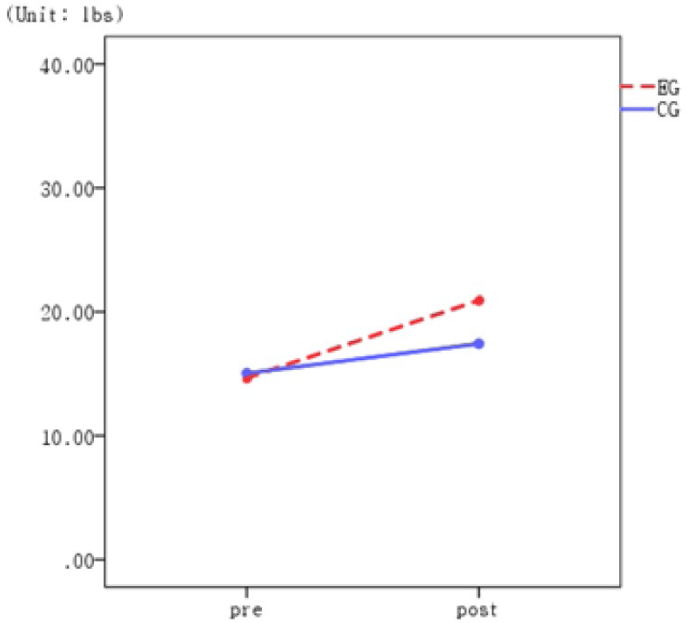
As a result of the 10-meter walking test of the control group and the experimental group, walking time was shortened in both groups, but statistically significant results were not found (Table 4).
| Time | F | P | ||||
|---|---|---|---|---|---|---|
| Pre-test | Post-test | |||||
| 10MWT | EG | 15.18±6.90 | 13.34±7.73 | Time | 4.215 | 0.053 |
| Group | 5.203 | 0.033* | ||||
| CG | 24.43±13.11 | 22.80±10.72 | Time*Group | 0.016 | 0.899 | |
As a result of the plantar pressure measurement test of the control group and the experimental group, no statisti-cally significant results were found (Table 5).
DISCUSSION
In this study, we analyzed the effects of wall squat exercise using elastic bands on leg muscle strength, gait, and plantar pressure in patients with chronic stroke. As a result of the study, both the experimental group with elastic bands and the control group without elastic bands showed significant improvements in leg muscle strength and walking ability, but more significant improvements were observed in the experimental group.
It was confirmed that wall squat exercise using elastic bands is effective in strengthening leg muscle strength. In particular, the improvement in leg muscle strength on the paralyzed side was remarkable, which is consistent with previous studies. In a study, resistance exercise using elastic bands was reported to be effective in strengthening leg muscle strength.33 And in a study, resistance exercise using elastic bands was reported to be effective in improving muscle strength in stroke patients.34 In this study, it appears that resistance exercise using elastic bands induced an increase in leg muscle strength. These findings support that elastic band–based resistance training is a viable method for improving lower limb strength in chronic stroke.
In comparison, the general squat exercise quadriceps muscle thigh It was reported that it is effective in increasing the strength of the biceps femoris.14 However, in this study, the activity of the middle gluteus muscle was increased more effectively by adding an elastic band, which also had a positive effect on walking stability. Therefore, it is suggested that wall squat exercise using an elastic band may be a more effective approach to improving leg muscle strength than simple squat exercise.
In addition, the experimental group showed improvement in time reduction in the 10-meter walk test compared to the control group. This is similar to what was reported in the study, and means that the elastic band contributed to improving walking stability by increasing the coordination of the hip and knee joints.21 In particular, a study reported that hip arthroplasty played an essential role in independent walking and balance recovery, and this study also con-firmed that resistance exercise using elastic bands increased the activity of hip arthroplasty muscles, which had a positive effect on improving balance and walking ability.24
In this study, the results of plantar pressure measurement showed that the forefoot and hindfoot of the experimental group The distribution of plantar pressure changed to become more balanced. This indicates that, although stroke patients tend to have their weight shifted to the non-paralyzed side, the elastic band application exercise helped improve weight distribution to be more symmetrical. These results were also confirmed in the study, suggesting that a balanced distribution of plantar pressure is an important factor in improving walking stability.30
This study has several limitations. First, this study may not have ruled out the influence of other rehabilitation treatments besides exercise intervention. Therefore, future research requires a research design that more thoroughly controls the control group. Second, the number of study subjects was limited, which may limit the generalization of the study results. Future research should include more subjects to increase the reliability of the study. Third, the study period was set to 6 weeks, which may be insufficient to verify the long-term effects. Therefore, follow-up research is needed to analyze the long-term effects of wall squat exercise using elastic bands.
CONCLUSIONS
This study proved that wall squat exercise using elastic bands is effective in improving leg muscle strength, gait, and plantar pressure in stroke patients. The results showed that the experimental group using elastic bands had greater improvements in leg muscle strength than the control group, improved static and dynamic balance ability, and significantly increased walking ability. In addition, it was shown that the distribution of plantar pressure changed to be more balanced, which also contributed to improving walking stability. These results suggest that wall squat exercise using elastic bands can be an effective intervention method for the rehabilitation of chronic stroke patients, and that exercise using elastic bands can be expected to improve leg muscle strength, balance, and walking ability more than conventional wall squat exercise. Additional research and clinical application should be conducted so that this exercise method can become a standard exercise treatment in the rehabilitation process of stroke patients.








